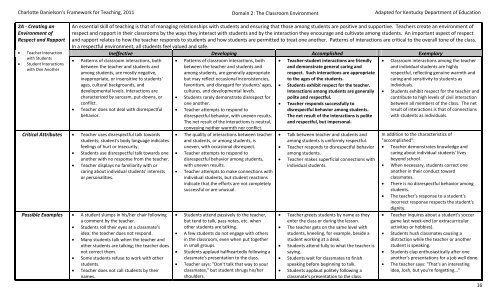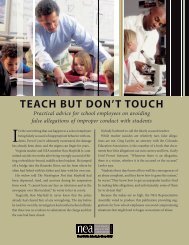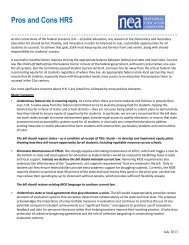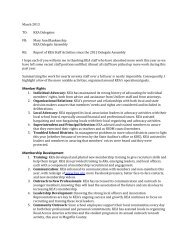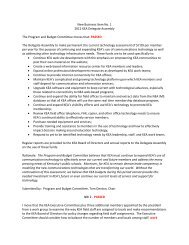Kentucky Adapted Danielson 2011 Framework - Kentucky Education ...
Kentucky Adapted Danielson 2011 Framework - Kentucky Education ...
Kentucky Adapted Danielson 2011 Framework - Kentucky Education ...
Create successful ePaper yourself
Turn your PDF publications into a flip-book with our unique Google optimized e-Paper software.
Charlotte <strong>Danielson</strong>’s <strong>Framework</strong> for Teaching, <strong>2011</strong><br />
Domain 2: The Classroom Environment<br />
<strong>Adapted</strong> for <strong>Kentucky</strong> Department of <strong>Education</strong><br />
2A - Creating an<br />
Environment of<br />
Respect and Rapport<br />
<br />
<br />
Teacher Interaction<br />
with Students<br />
Student Interactions<br />
with One Another<br />
An essential skill of teaching is that of managing relationships with students and ensuring that those among students are positive and supportive. Teachers create an environment of<br />
respect and rapport in their classrooms by the ways they interact with students and by the interaction they encourage and cultivate among students. An important aspect of respect<br />
and rapport relates to how the teacher responds to students and how students are permitted to treat one another. Patterns of interactions are critical to the overall tone of the class.<br />
In a respectful environment, all students feel valued and safe.<br />
Ineffective Developing Accomplished Exemplary<br />
<br />
<br />
Patterns of classroom interactions, both<br />
between the teacher and students and<br />
among students, are mostly negative,<br />
inappropriate, or insensitive to students'<br />
ages, cultural backgrounds, and<br />
developmental levels. Interactions are<br />
characterized by sarcasm, put-downs, or<br />
conflict.<br />
Teacher does not deal with disrespectful<br />
behavior.<br />
Critical Attributes Teacher uses disrespectful talk towards<br />
students; student's body language indicates<br />
feelings of hurt or insecurity.<br />
Students use disrespectful talk towards one<br />
another with no response from the teacher.<br />
Teacher displays no familiarity with or<br />
caring about individual students' interests<br />
or personalities.<br />
Possible Examples A student slumps in his/her chair following<br />
a comment by the teacher.<br />
Students roll their eyes at a classmate's<br />
idea; the teacher does not respond.<br />
Many students talk when the teacher and<br />
other students are talking; the teacher does<br />
not correct them.<br />
Some students refuse to work with other<br />
students.<br />
Teacher does not call students by their<br />
names.<br />
<br />
<br />
<br />
<br />
<br />
<br />
<br />
<br />
<br />
<br />
Patterns of classroom interactions, both<br />
between the teacher and students and<br />
among students, are generally appropriate<br />
but may reflect occasional inconsistencies,<br />
favoritism, and disregard for students' ages,<br />
cultures, and developmental levels.<br />
Students rarely demonstrate disrespect for<br />
one another.<br />
Teacher attempts to respond to<br />
disrespectful behavior, with uneven results.<br />
The net result of the interactions is neutral,<br />
conveying neither warmth nor conflict.<br />
The quality of interactions between teacher<br />
and students, or among students, is<br />
uneven, with occasional disrespect.<br />
Teacher attempts to respond to<br />
disrespectful behavior among students,<br />
with uneven results.<br />
Teacher attempts to make connections with<br />
individual students, but student reactions<br />
indicate that the efforts are not completely<br />
successful or are unusual.<br />
Students attend passively to the teacher,<br />
but tend to talk, pass notes, etc. when<br />
other students are talking.<br />
A few students do not engage with others<br />
in the classroom, even when put together<br />
in small groups.<br />
Students applaud halfheartedly following a<br />
classmate's presentation to the class.<br />
Teacher says: "Don't talk that way to your<br />
classmates," but student shrugs his/her<br />
shoulders.<br />
<br />
<br />
<br />
<br />
<br />
<br />
<br />
<br />
<br />
<br />
<br />
Teacher-student interactions are friendly<br />
and demonstrate general caring and<br />
respect. Such interactions are appropriate<br />
to the ages of the students.<br />
Students exhibit respect for the teacher.<br />
Interactions among students are generally<br />
polite and respectful.<br />
Teacher responds successfully to<br />
disrespectful behavior among students.<br />
The net result of the interactions is polite<br />
and respectful, but impersonal.<br />
Talk between teacher and students and<br />
among students is uniformly respectful.<br />
Teacher responds to disrespectful behavior<br />
among students.<br />
Teacher makes superficial connections with<br />
individual students.<br />
Teacher greets students by name as they<br />
enter the class or during the lesson.<br />
The teacher gets on the same level with<br />
students, kneeling, for example, beside a<br />
student working at a desk.<br />
Students attend fully to what the teacher is<br />
saying.<br />
Students wait for classmates to finish<br />
speaking before beginning to talk.<br />
Students applaud politely following a<br />
classmate's presentation to the class.<br />
<br />
<br />
Classroom interactions among the teacher<br />
and individual students are highly<br />
respectful, reflecting genuine warmth and<br />
caring and sensitivity to students as<br />
individuals.<br />
Students exhibit respect for the teacher and<br />
contribute to high levels of civil interaction<br />
between all members of the class. The net<br />
result of interactions is that of connections<br />
with students as individuals.<br />
In addition to the characteristics of<br />
"accomplished":<br />
Teacher demonstrates knowledge and<br />
caring about individual students' lives<br />
beyond school.<br />
When necessary, students correct one<br />
another in their conduct toward<br />
classmates.<br />
There is no disrespectful behavior among<br />
students.<br />
The teacher's response to a student's<br />
incorrect response respects the student's<br />
dignity.<br />
Teacher inquires about a student's soccer<br />
game last week-end (or extracurricular<br />
activities or hobbies).<br />
Students hush classmates causing a<br />
distraction while the teacher or another<br />
student is speaking.<br />
Students clap enthusiastically after one<br />
another's presentations for a job well done.<br />
The teacher says: "That's an interesting<br />
idea, Josh, but you're forgetting..."<br />
16


